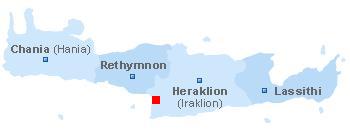|
|

 The Agia Triada is a large Minoan excavation in the south of the island of Crete, close to the town of Timpaki. By the Italian archaeologists who have excavated the site it was named after a nearby abandoned medieval village that was destroyed by the Turks. If you drive eastwards from Timpaki towards Mires, the first exit on the right hand side goes to Kalamaki Beach and just after that you see the brown sign for the exit to the Agia Triada. The last few hundred meters to the Minoan excavations go over a dirt road. That was the case in 1975 when I first came to see the place, and when I came back in 2011 it was still unchanged. Nowadays you end up at a parking, which was not there before, and the ticket house at the excavation is also new. I'm not sure if it always goes like this, but the ticket house is staffed and you get a beautiful ticket stating that the price of entrance is zero euro and you get a leaflet with a map and a story on it. Maybe you should take time to read it, but I my impression was that nobody did, and also the map is so small and unclear in terms of numbers on them, that I could not figure out what was where and what.
The Agia Triada is a large Minoan excavation in the south of the island of Crete, close to the town of Timpaki. By the Italian archaeologists who have excavated the site it was named after a nearby abandoned medieval village that was destroyed by the Turks. If you drive eastwards from Timpaki towards Mires, the first exit on the right hand side goes to Kalamaki Beach and just after that you see the brown sign for the exit to the Agia Triada. The last few hundred meters to the Minoan excavations go over a dirt road. That was the case in 1975 when I first came to see the place, and when I came back in 2011 it was still unchanged. Nowadays you end up at a parking, which was not there before, and the ticket house at the excavation is also new. I'm not sure if it always goes like this, but the ticket house is staffed and you get a beautiful ticket stating that the price of entrance is zero euro and you get a leaflet with a map and a story on it. Maybe you should take time to read it, but I my impression was that nobody did, and also the map is so small and unclear in terms of numbers on them, that I could not figure out what was where and what.
Another thing that has changed is that over the years a lot more has been excavated at the Agia Triada palace. When I was there for the first time came in 1975 it was still labeled a Minoan summer villa of the rulers of the Palace of Pheastos which is situated three kilometers further away, but as more of Agia Triada was exposed (in 1976 they continued the digging), the true extent of the complex came up and now there is doubt about its former function. Especially when beautiful frescoes were found, much prettier than those that were already excavated at Phaistos, a theory raised that the palace of Agia Triada, after its construction in 1550 BC, was the real seat of the Minoan king, and that Phaistos had become more a place with a religious function. Summer Villa or small palace, Agia Triada remains an interesting place to visit.
From all Minoan palaces the Agia Triada palace has the most beautiful views. It lies on a hillside overlooking the Messara plain and the mountains beyond. It is pleasant that it is not a major tourist attraction like for example the Palace of Knossos, where the tour buses are lined up to get people inside and where you have to look at the excavations with hundreds of people in a row. It is also more of the route from the really large tourist resorts like Malia and Hersonissos, which are at quite some distance. Here at Agia Triada it is relatively very quiet and you can take the time to view everything and take pictures without constantly people appearing in front of your lens. When we were there in September 2011 there were I think about ten to twenty people.
|










